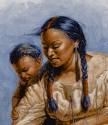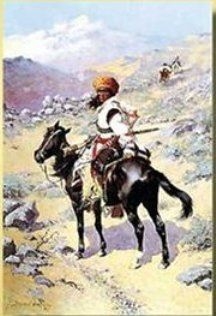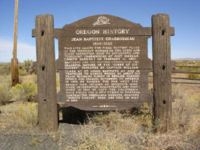 |
| Pomp with Sacagawea |
The youngest member of the Lewis and Clark expedition, Jean Baptiste Charbonneau was born at Fort Mandan on February 11th, 1805 to Shoshoni woman Sacagawea and French-Canadian Toussaint Charbonneau. William Clark nicknamed him "Pomp" for his pompous “little dancing boy” antics (pbs.org). Historically, Pomp is mentioned mainly for his journey as an infant on his mother’s back with the Corps of Discovery. Most history books provide little information on Pomp’s life past the end of Lewis and Clark’s Journey.
In December 28, 1809 Pomp was baptized in a Catholic Cathedral in St. Louis. At William Clark’s request Pomp stayed in St. Louis to be educated. He studied classical literature, math, history, science, French and English. Pomp’s parents left St. Louis in 1811 to return to the Fort Mandan area. In 1812 Sacagawea became ill and died. In June of 1823 Pomp was introduced to Prince Paul William of Wurttemberg by William Clark. He traveled to Europe with Prince Paul that same year. Pomp lived in the Wurttemberg castle for over two years and preferred to be called by his given name, Jean Baptiste. During this time he learned the language, and studied and traveled throughout Europe (Lewisandclark.org).
 |
| Depiction of Pomp (Michael Lance Ritter's book, Jean Baptiste Charbonneau: Man of Two Worlds) |
By 1829 Jean Baptiste was back in the Western United States working as a trapper and guide. He is noted to have traveled with Jim Bridger, Jim Beckwourth, and Joe Meek (nps.org). In 1843 Toussaint Charbonneau died at the age of 86 and Jean Baptiste settles his estate. In 1846 Jean Baptiste became a guide for the Mormon Battalion from Santa Fe to San Diego during the Mexican War. He then spent several years working in the gold fields in California (Lewisandclark.org). In 1847 Jean Baptiste became the magistrate of the San Luis Rey Mission, a position he could not have held had he not been baptized Catholic. Jean Baptiste resigned from this position within a year because of the problems between the Native Americans and the mission. Jean Baptiste had often been an interpreter between the Native Americans and the United States government. Some speculate that he disliked the treatment of the people of his heritage and so left his position as magistrate (Lewisandclark.org).
In 1861 Jean Baptiste was listed as a hotel clerk at the Orleans Hotel in Auburn, California. In 1866 Jean Baptiste left for the gold fields in Montana, but died on his way of pneumonia. On May 16, 1866, Inskip Station, Oregon was the final resting place of 61 year old Jean Baptiste Charbonneau. A memorial is now found at this location in the southeast corner of Oregon’s volcanic high desert country, near modern day Danner, Oregon, three miles north of highway 95 (nps.gov).
 |
| Jean Baptiste Charbonneau's Memorial (www.wikipedia.com) |
A monument in his name reads:
"This site marks the final resting place of the youngest member of the Lewis and Clark Expedition. Born to Sacagawea and Toussaint Charbonneau at the Mandan Village (North Dakota) on February 11th 1805. Baptiste and his mother symbolize the peaceful nature of the “Corps of Discovery". Educated by Captain William Clark at St. Louis. Baptiste at age 18 traveled to Europe where he spent six years becoming fluent in German, French, and Spanish. Returning to America In 1829, he ranged the far west for nearly four decades. As mountain man, guide, interpreter, magistrate, and forty niner. In 1866, he left the California gold fields for a new strike in Montana, contracted pneumonia in route, reached “Inskips Ranche”, here and died on May 16, 1866."
Jean Baptiste Charbonneau was chosen as my hero because of the citizenship traits that he embodies. He cooperated with many different peoples as a guide and an interpreter in both peace and war time. Jean Baptiste was respectful of authority and the differences in the people that he encountered at home and abroad. He also worked to make his community and country a better place by attempting to bring peaceable agreement between the native peoples and the United States government. Jean Baptiste carried on his mother's tradition of peaceful guide and interpreter. Into his sixties, Jean Baptiste continued with his adventurous citizen spirit with his journey to Montana. Beginning his life traveling across the North American continent, Jean Baptiste would end his life traveling it once more.
Page created on 12/4/2007 12:00:00 AM
Last edited 12/4/2007 12:00:00 AM
National Park Servic, Website. "Jean Baptiste Charbonneau." [Online] Available http:www.nps.gov/archive/jeff/LewisClark2/CorpsOfDiscovery/TheOthers/Civilians/JeanBaptiste.
Lewis and Clark.org, website. "Time Line: The Life of Jean Baptiste Charbonneau, "Pomp"." [Online] Available http://www.lewisandclark.org/pages/userimages/uploadpdfs/Pomp_Timeline.pdf.
Lewis and Clark Trai, website. "Sacagawea and Baby Jean Baptiste." [Online] Available http://www.lewisandclarktrail.com/sacagaweasbaby.htm.
